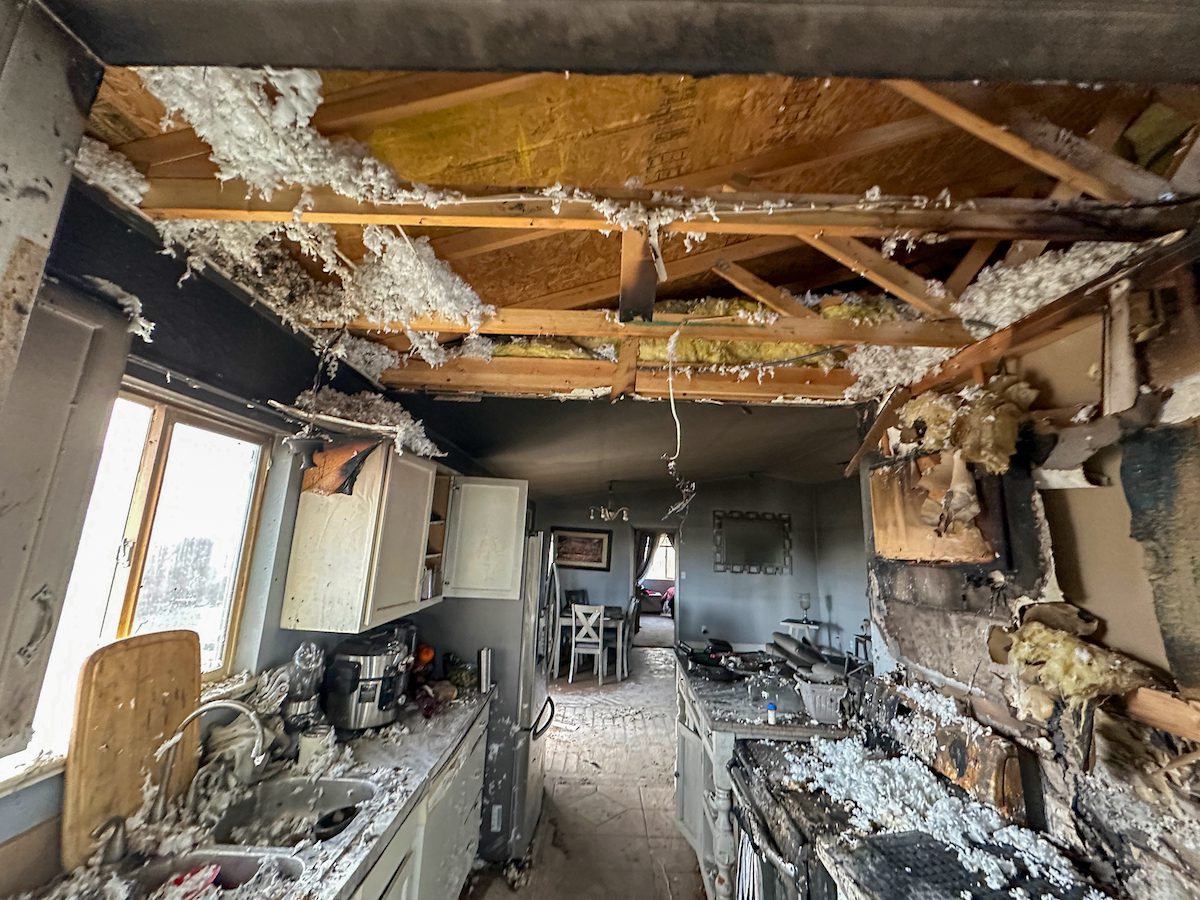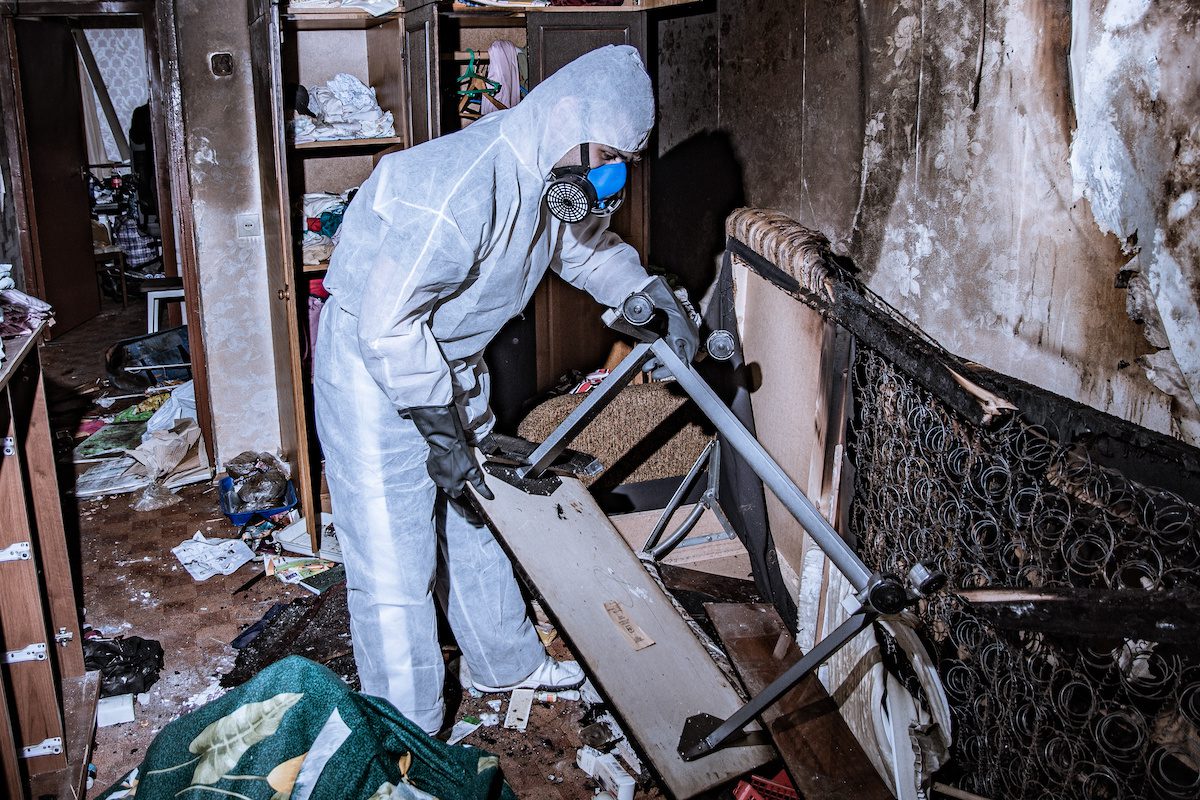Fires are one of the most destructive disasters your home can face. Outside of the immediate fear for the safety of loved ones, the structural damage, lost or ruined personal belongings, and general feeling of displacement can be devastating. Smoke odors, burned infrastructure, and possible water damage from extinguishing efforts make the road to fire damage restoration feel long and tedious.
But it doesn’t have to be that way. All it takes is a little preparation, and the right action at critical moments. And the Fire Damage Restoration Guide from Flood Response can help you return your home, family, and life to a place of normalcy in no time.
Do: Practice Fire Prevention Safety
Obviously, one of the best ways to respond to a house fire is to do everything in your power to prevent one in the first place. Electrical fires are common causes of house fires. So do your due diligence to check on any potentially dangerous exposure points:
- Unprotected Outlets
- Faulty-wired lighting
- Damaged or improperly used electrical cords
- Overloaded circuits
Any major appliance in your home like dish washers, laundry machines, and electric stoves should always be plugged directly into a wall outlet (never use extension cords or power strips!).
Additionally, always be aware of potentially dangerous situations arising in your home. Think flickering lights, tripped circuit breakers, or switches that are hot to the touch. Even areas that are exposed to the elements can quickly become a potential fire hazard. A leak in your home during a rainstorm that trickles near an electrical outlet, for example.
Finally, the National Fire Protection Association (NFPA), suggests smoke alarms should be installed on every level of your home, including basements. Be sure to test them monthly and change batteries annually to ensure they’re working effectively. Creating simple safety checklists in your home can make all the difference in fire prevention. And can help you avoid the need for fire damage restoration altogether.
Have an Escape Plan
Often, failure to plan is planning to fail. Should you or your family find yourself in an emergency like a house fire, hopefully you already have a fire escape plan in place.
The American Red Cross offers a useful guide to customize on your own. In general your 2-minute fire escape drill should include:
- Two escape routes from each room in your home that every family member knows.
- A designated meeting place outside of your home once everyone reaches safety.
- Additional fire escape methods like fire escape ladders for second and third story windows.
Always maintain a sense of urgency to stay low to avoid smoke and move quickly! Never go back inside a burning structure once you reach safety and dial 9-1-1 as soon as possible so more help can arrive.

What to Do in the Immediate Aftermath of a House Fire
Unfortunately, some disasters are unavoidable. If you’ve experienced a house fire, your first course of action is to make sure everyone in the home has reached safety (remember, have an escape plan!). Call 9-1-1 immediately for first responders to arrive. They’ll rescue anyone who has not been accounted for, and extinguish flames and potentially salvage some of the burning structure.
Do:
- Call 9-1-1
- Let family and friends know you’re safe
- Provide minor first aid care to anyone in need before first responders arrive
Do Not:
- Re-enter the building under any circumstances, even if the fire has been extinguished. There can be severe structural damage even in areas of your home that appear to not be burned.
Once fire authorities determine a structure is safe to re-enter, you can take stock of the initial damage. In the coming days and weeks, you may be in touch with insurance providers to help replace lost or damaged items, but a professional fire restoration company can often help you with the heavy lifting and general logistics.
When you call Flood Response, our team will spring to immediate action after a house fire and help you:
- Find accommodations for you and your family to stay in the short term if your home needs to be evacuated.
- Pack out and store your belongings from affected rooms off site and away from further damage.
- Create a long-term plan so your life isn’t on hold during the restoration process.
Flood Response will even communicate directly with your home insurance company on your behalf. With so much happening in the immediate aftermath of a fire, our team can be there every step of the way towards recovery.
Assessing Fire Damage
Fire damage restoration requires a comprehensive approach to understanding the extent and type of fire damage. For one, the damage from fires can spread much further than it seems at first glance. Even a small fire can cause catastrophic damage to walls, electrical wiring, cabinetry, flooring, and plumbing. There are three major types of fire damage that our restoration team will address:
- Thermal injury to and/or destruction of belongings and infrastructure
- Lingering smoke and odor
- Water damage from extinguishing the fire
As our team packs out furniture, items and personal belongings to store offsite, we try to salvage as much as possible. Smoke can easily penetrate substances like clothing, glass, ceramic, and hardwood flooring. Even if not directly exposed to fire, they often require professional treatment.
Smoke Damage
Smoke damage can spread almost as quickly as the fire itself. As soon as our team arrives, we will evaluate the smoke damage and immediately begin any necessary mitigation procedures. We typically target five types of smoke and residue damage to ensure containment while replacing or restoring any damaged surfaces:
- Wet smoke residue: Low heat and smoldering fires that leave behind smoke webs and a sticky residue. The pungent residue requires specialized care to fully remove.
- Dry smoke residue: When fast fires burn at high temperatures, they leave behind powdery ash. While it doesn’t smear like wet smoke residue, it has a pungent odor.
- Protein residue: Kitchen fires frequently leave behind protein residue from food and oils. They can ruin paint and varnishes when not removed quickly. Left unchecked, this type of residue can grow rancid and spread pathogens.
- Fuel oil soot: When furnaces malfunction and puff back, they can distribute fuel oil soot in the space around it. This dangerous soot can spread stains, and even act as fuel for another fire.
- Other residues: Fire extinguishers, chemicals from firefighters, and fingerprint powder all leave behind residue that can cause damage.
At Flood Response, we have thorough treatment plans to address every form of smoke residue and odor resulting from a house fire and its aftermath. Because our team looks for each type of residue, your home can avoid the long-term structural risks and odors of smoke residue.

Do: Call Experienced Fire Damage Restoration Professionals
When Flood Response arrives at the scene of a fire, our IICRC-certified team will immediately inspect the affected area and any potential areas of that the fire damage could have spread to. Our team thoroughly documents any issues that need addressed in the fire damage restoration process, including:
- Smoke Damage
- Soot Damage
- Property and Structural Damage
- Traces of Odors
Fire damage restoration isn’t just about fixing the visible damage. It’s about making sure your home is structurally sound for your return. Flood Response fire damage restoration services include complete management and expert rebuilding of your home’s damaged interior. It’s our goal to bring it as close to its original style and condition as possible.
Our team of general contractors will work hard to replace, repair, or remodel the damaged areas of your home from floor to ceiling, providing you with a sense of calm renewal after the devastating destruction.
The Flood Response Fire Damage Restoration Process
The immediate time after a fire is crucial to safely salvage as much as possible. But at Flood Response, we also understand it can be confusing to know what steps to take first. Not to mention the potential emotional toll of going through a life-threatening disaster.
Here’s what you can expect when working with Flood Response’s Fire Damage Restoration Team:
- Assessment: Our team of IICRC certified experts will comprehensively evaluate your home to find both the obvious and the hidden fire damage. They’ll also be on the lookout for the five key types of smoke damage and residue. Early documentation from the start is essential for our team to work directly with your insurance company.
- Secure your property: Once we’ve identified the extent of all the fire damage, we’ll coordinate the removal, cleaning, and storage of your belongings. We’ll also board up and/or tarp any openings on the property such as windows and roofs. The seal will protect it from further damage from the elements and we’ll also install protective fencing if necessary.
- Water removal and dry out: Firefighting requires a lot of water, some of which will inevitably remain in your home. We will remove the water and dry out the affected areas with dehumidifiers and specialized equipment to prevent mold damage.
- Demolition and removal of debris: After the water in your home has been remediated, we’ll demolish anything that can’t be sufficiently dried out – like drywall or wooden surfaces – and remove all the remaining debris. We’ll also demolish and remove any surfaces and structures affected by the fire itself.
- Clean-up & smoke removal: Flood Response will remove all traces of soot and damage from walls, ceilings, and other interior spaces to prepare them for restoration. Throughout the project, we will continue to monitor for traces of remaining smoke and soot to avoid further long-term damage and issues.
- Construction and restoration: Our team will manage the whole process of reconstruction, remodeling, and inspections. That way, you work with one point of contact and can focus on your family and day-to-day responsibilities. We work hard to restore both the visible surfaces and the out-of-sight structures to your house. Your home will feel like home again when you eventually return.
- Final cleanup: Our job isn’t complete until your home is totally safe to live in again. After the last nail has been hammered in, we will clean each affected area from deodorizing carpets to sealing tile floors. We’ll even clean your air ducts so that every trace of smoke odor and construction dust is gone.
Home disasters can be scary and overwhelming, but you shouldn’t have to face the unknown alone. Flood Response is ready 24/7 when your home requires emergency fire damage restoration services.
Make Your First Response, Flood Response Whenever Disaster Strikes.
If your home has suffered a fire, outside of the immediate danger to yourself and loved ones, the damage can quickly spread throughout the entire structure. But even once the fire has been put out, it can be a long road to recovery.
In the moment, fires can be one of the most catastrophic disasters your home or business faces. But once the fire is extinguished, our rapid response team of fire damage restoration experts can quickly be onsite to begin disaster mitigation and property restoration services in the face of fire and smoke damage.
For over 20 years, we’ve helped families and business owners in the Coachella Valley area take the right steps to restore their properties and rebuild their lives in the face of disaster. Are you looking for a reliable, full-service disaster recovery service in the Coachella Valley or the surrounding area? Contact Flood Response today!

 Contact
Contact